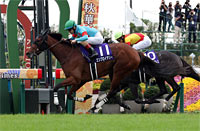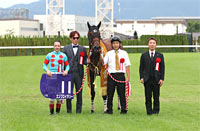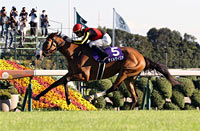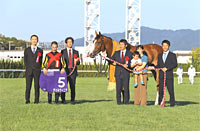Shuka Sho (G1) - Data Analysis
Final leg of the Triple Crown for 3-year-old fillies boasting a string of famous winners
Of the 23 previous Shuka Sho winners, only seven runners have not achieved a win in a G1 race (including overseas G1 race) other than the Shuka Sho from their debut to retirement, and only three runners in this group have also not achieved a second-place finish in such a race. In other words, this highly anticipated race brings together runners with a track record of success in G1 races limited to 2- and 3-year-old fillies, and fillies aiming to break through in major races going forward. In addition, of the same 23 winners, 15 were backed as 2nd favorite or higher, and 14 runners in this group had win odds of below 4. Although the Shuka Sho is no stranger to upsets (massive Trifecta payout of 10,982,020 yen in 2008), highly favored horses basically have the edge. Let’s now analyze some features shared by successful runners in this race based on results over the last 10 years.
Check performance from start of the year and finish in previous race
Of the 30 Top 3 finishers over the last 10 years, 13 had won “a JRA G1 or G2 race in the same year.” This group of runners also achieved a Top 3 ratio of 44.8%. It seems we can therefore place our trust in runners that have won a higher-grade race since the start of the year. [Table 1]
[Table 1] Performance by experience of winning a “G1 or G2 race in the same year” (last 10 years)
| Win experience |
Performance
[1st-2nd-3rd-4th or lower] |
Win ratio |
Top 2 ratio |
Top 3 ratio |
| Yes |
5-4-4-16 |
17.2% |
31.0% |
44.8% |
| No |
5-6-6-132 |
3.4% |
7.4% |
11.4% |
In addition, among runners that had not won “a JRA G1 or G2 race in the same year,” those that had finished 4th or lower in their previous race produced zero winners and only achieved a Top 3 ratio of 2.7%. In other words, we should lower our expectations of runners that have not won a higher-grade race since the start of the year and did not finish in the Top 3 of their previous races. [Table 2]
[Table 2] Among runners that had not won “a JRA G1 or G2 race in the same year,” performance by finish in previous race (last 10 years)
| Finish in previous race |
Performance
[1st-2nd-3rd-4th or lower] |
Win ratio |
Top 2 ratio |
Top 3 ratio |
| Top 3 |
5-5-5-61 |
6.6% |
13.2% |
19.7% |
| 4th or lower |
0-1-1-71 |
0% |
1.4% |
2.7% |
Focus on runners that have won a middle- to long-distance race
Of the 30 Top 3 finishers over the last 10 years, 29 (excluding runner-up Kyowa Jeanne in 2011) had won “a JRA 1,800m+ race.” Conversely, runners without such experience only achieved a Top 3 ratio of 2.1%. This suggests that runners that have never won a middle- to long-distance race have little chance of rising to the top. [Table 3]
[Table 3] Performance by experience of winning a “JRA 1,800m+ race” (last 10 years)
| Win experience |
Performance
[1st-2nd-3rd-4th or lower] |
Win ratio |
Top 2 ratio |
Top 3 ratio |
| Yes |
10-9-10-101 |
7.7% |
14.6% |
22.3% |
| No |
0-1-0-47 |
0% |
2.1% |
2.1% |
In addition, the 21 Top 3 finishers since 2012 had all won “a JRA 1,800m+ race with a time difference of 0.1s or more over the runner-up.” In other words, we should expect little from runners that have not won a middle- to long-distance race and from runners that have only won such a race without a time difference. [Table 4]
[Table 4] Performance by experience of “winning a JRA 1,800m+ race with a time difference of 0.1s or more over the runner-up” (last 7 years)
| Win experience |
Performance
[1st-2nd-3rd-4th or lower] |
Win ratio |
Top 2 ratio |
Top 3 ratio |
| Yes |
7-7-7-57 |
9.0% |
17.9% |
26.9% |
| No |
0-0-0-46 |
0% |
0% |
0% |
Check the closing speed last time out
Of the 30 Top 3 finishers over the last 10 years, 20 “had contested a JRA race last time out and were ranked “3rd or higher” in their estimated time over the final three furlongs in that race.” Conversely, runners that were ranked “4th or lower” struggled with a Top 3 ratio of 9.0%. When comparing performance last time out, we need to pay attention not only to the finish but also to the closing speed. [Table 5]
[Table 5] Among runners that had contested a JRA race last time out, performance by ranking in estimated time over final three furlongs in that race (last 10 years)
Ranking by estimated time over
final three furlongs last time out |
Performance
[1st-2nd-3rd-4th or lower] |
Win ratio |
Top 2 ratio |
Top 3 ratio |
| 3rd or higher |
8-7-5-46 |
12.1% |
22.7% |
30.3% |
| 4th or lower |
2-3-5-101 |
1.8% |
4.5% |
9.0% |
In addition, among runners that “had contested a JRA race last time out and were ranked “4th or lower” in their estimated time over the final three furlongs in that race,” runners starting in brackets “3–8” struggled to an even greater extent with a Top 3 ratio of 4.5%. This means we should lower our expectations of runners that did not stand out much in the final sprint last time out and start the Shuka Sho in bracket 3 or higher.[Table 6]
[Table 6] Among runners that had contested a JRA race last time out and were ranked “4th or lower” in their estimated time over the final three furlongs in that race, performance by bracket number (last 10 years)
| Bracket number |
Performance
[1st-2nd-3rd-4th or lower] |
Win ratio |
Top 2 ratio |
Top 3 ratio |
| 1, 2 |
1-2-3-17 |
4.3% |
13.0% |
26.1% |
| 3-8 |
1-1-2-84 |
1.1% |
2.3% |
4.5% |
Runners with long careers struggle
Of the 30 Top 3 finishers over the last 10 years, 25 had “8 or fewer” career starts. Conversely, runners with “9 or more” career starts had a Top 3 ratio of only 6.8%. If we limit our analysis to the seven races from 2012, the latter group struggled to an even greater extent with performance of [1-0-1-44] (Top 3 ratio of 4.3%). In other words, we should raise our expectations of runners with comparatively shorter careers. [Table 7]
[Table 7] Performance by career starts (last 10 years)
| Career starts |
Performance
[1st-2nd-3rd-4th or lower] |
Win ratio |
Top 2 ratio |
Top 3 ratio |
| 8 or fewer |
9-8-8-80 |
8.6% |
16.2% |
23.8% |
| 9 or more |
1-2-2-68 |
1.4% |
4.1% |
6.8% |
Seek out the winner!
Runners backed as 5th favorite or lower in previous race struggle to pull off a victory
The last seven winners had all been backed as 4th favorite or higher in their previous race. In fact, the only runner to pull off a victory after having been backed as 5th or lower in her previous race since 1996 (the year in which the first Shuka Sho race was held) was Buzen Candle in 1999. That means we should expect little from runners that were not among the higher favorites in their previous race. Other features shared by the seven winners were that they “had won a JRA 1,800m+ race with a time difference of 0.1s or more over the runner-up,” and that they were ranked 3rd or higher in their estimated time over the final three furlongs last time out. In other words, we should also focus on the trends outlined in Tables 4-5. [Table 8]
[Table 8] Winners’ “favoritism in previous race,” “highest time difference with runner-up in JRA 1,800m+ race that was won,” and “ranking in estimated time over the final three furlongs last time out” (last 7 years)
| Year |
Winner |
Favoritism in
previous race |
Highest time difference with runner-up
in “JRA 1,800m+ race” that was won |
Ranking by estimated
time over final three
furlongs last time out |
| 2012 |
Gentildonna |
1st favorite |
0.8s (2012 Yushun Himba (Japanese Oaks)) |
3rd |
| 2013 |
Meisho Mambo |
4th favorite |
0.2s (2013 Yushun Himba (Japanese Oaks)) |
3rd |
| 2014 |
Shonan Pandora |
1st favorite |
0.4s (2014 Itoigawa Tokubetsu) |
2nd |
| 2015 |
Mikki Queen |
1st favorite |
0.1s (2015 Yushun Himba (Japanese Oaks), etc.) |
1st |
| 2016 |
Vivlos |
3rd favorite |
0.7s (2016 3yo+ 1-win class) |
2nd |
| 2017 |
Deirdre |
1st favorite |
0.3s (2017 Yaguruma Sho) |
3rd |
| 2018 |
Almond Eye |
1st favorite |
0.3s (2018 Yushun Himba (Japanese Oaks)) |
1st |
(Masaya Ibuki)
|


















